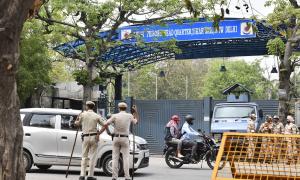Crude at $100 per barrel is going to have an adverse impact on marketing companies, especially if you look at the product price under recoveries which are going on. Petroleum has an under recovery of nearly Rs 9.5, diesel Rs 11.3, LPG Rs 380 per cylinder, and kerosene Rs 21. So, that is a huge under recovery burden which the industry is carrying as of now. This includes marketing, which has to be shared equally between marketing companies, upstream companies, and the government.
At the beginning of the year, the government has approved nearly Rs 24,000 (Rs 240 billion) crore in oil bonds. They have issued Rs 12,000 crore (Rs 120 billion) for Q1 and Q2, and the remaining has to be issued to oil marketing companies. In the first half of the year, when oil bonds were issued to companies, oil-marketing companies took the biggest hit in terms of sharing of subsidy while the burden for upstream companies was much lower.It is likely that in the second half of the year, the burden may shift to upstream companies. This means companies like ONGC and Oil India might be hit because of this additional burden which they might have to take because of crude going to $100 per barrel.
The Indian crude basket is trading at $92.29 per barrel, which is its all-time high. This is the highest since November 26, when the Indian basket was trading at $92.13 per barrel. The average for FY08 comes to around $74.58 per barrel. Compared to FY07, the average was around $62.46 per barrel. This is an about $12 increase in the Indian basket of crude. So, that impact which will be there. The subsidy burden will be shared in FY08 was estimated at around Rs 54,900 crore (Rs 549 billion). That is expected to touch nearly Rs 60,000 crore (Rs 600 billion). Upstream companies were bearing a burden of nearly Rs 18,000 crore (Rs 180 billion). This burden is expected to go over Rs 20,000 crore (Rs 200 billion). According to ONGC's chairman, the company expects their burden to go over Rs 20,000 crore in FY08. This basically means that ONGC will have to bear a major chunk of that burden for upstream companies.On whether there will be a fuel price hike or a duty cut?
It is a political decision, which the government has to take. If you look at the last few elections, the Congress has not fared well in those two elections. It has been sending feelers to Left parties asking for a fuel price hike. The Left has been very reluctant in allowing that, so it is a question of how much the Finance Ministry is able to cut duties.The most important question is how much of the burden could be pass onto the consumer? Since February last year, there has not been any fuel price revision. Even in February, prices were reduced and not increased, so the revision upward has not happened for the last 8-10 months. Now, the big question is will the government pass on some burden to the consumer?
Last year, crude was trading at $70 per barrel in May, $80 per barrel in September, and $90 per barrel in November. It went as high as $99.29 per barrel in November, only to retreat later. It close the day at $96 per barrel but $100 per barrel it was. It did it yesterday in one physical lot. It was a 60 per cent gain, if you see over 2007. But the jury is still out on what kind of returns you will get today?
A lot of factors were at play yesterday which pushed crude above the $100 per barrel mark. First, the Nigerian geopolitical situation which came to the fore. Add to it what happened in Pakistan last week. Also, the biggest factor remains a weak dollar on the back of yesterday's ISM data, which was the lowest in the past 10 years.
Specifically, we will be watching the two data points. One is the factory orders data which comes out today. We are expecting it to come at 0.5 per cent. If it comes below that, again the dollar is going to get thrashed and because of that crude is going to gain out of it.
Second, we would be watching out for the Department of Energy's inventory data, which is likely to come tomorrow. It is the sixth week running where one saw a dip in reserves. This is the one which is creating the tension in the crude market right now, over and above the weak dollar.
We are expecting a further fall of 3.5 million barrels. This is in contrast to the 3.3 million barrels, which stood at 293.6 barrels. That is the strategic reserve or inventory levels that they have. Over and above this, the White House has come in and made some noise that they are not looking at opening out their strategic reserves to bring the price down. Now, we will be waiting and watching for what kind of statements does OPEC make. The next OPEC meeting is on February 1, so there is a lot for crude to play.
In international crude, the immediate support is at $99-98 per barrel. The first support is at $99 per barrel while the second support at $98 per barrel. The first resistance itself is $100 per barrel, which needs to be breached. The next one being $102 per barrel in the immediate short-term. If it breaches $102 per barrel, it is likely to go as high as $108-110 per barrel.
Post winter, you are likely to see a correction, experts said. The correction could make it fall to $90 per barrel. So, it is medium-term bearish and short-term positive on crude.
On how to play it in India?
On MCX crude January contract, the support would be immediately at Rs 3,880 per barrel and the next one would be at Rs 3,860 per barrel. It is a buy on dips. The dips would be when its touches the Rs 3,880 per barrel mark, with resistance coming at Rs 3915 per barrel, which was yesterday's high that it had made and the next one being at Rs 3,950 per barrel.








More from rediff